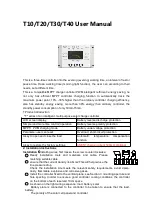
4.
Configure the power sensor with the following settings:
•
Maximum noise ratio
: 0.005 dB
•
Auto range
: Enabled
•
Power measurement
: Continuous average
•
Path selection
: Automatic
•
Averaging
: Automatic
•
Aperture
: 20 ms
•
Timeout
: 10 s
•
Frequency
:
Frequency
listed in the
Passband Flatness Accuracy Verification
table
5.
Configure the PXIe-5413 with the following settings:
•
Load impedance
: 50 Ω
•
Output mode
: Standard Function
•
Waveform type
: Sine
•
Amplitude
:
Amplitude range
listed in the
Passband Flatness Accuracy Verification
table
•
Frequency
:
Frequency
listed in the
Passband Flatness Accuracy Verification
table
•
Offset
: 0 V
6.
Wait 1 second for settling.
7.
Measure and record the power (dBm) using the power sensor.
•
When the power is measured at 0.05 MHz, record this as
P
Measured at 0.05 MHz
.
•
When the power is measured at all frequencies other than 0.05 MHz, record this as
P
Measured at
Current Test Frequency
.
8.
Skip this step if the PXIe-5413 frequency is configured to 0.05 MHz. Calculate the
passband flatness error using the following formula:
Passband Flatness Error
(dB) =
P
Measured at 0.05 MHz
-
P
Measured at
Current Test Frequency
where
P
Measured at 0.05 MHz
(dBm) and
P
Measured at
Current Test Frequency
(dBm) are values for
power measured at the same amplitude range listed in the
Passband Flatness Accuracy
Verification
table.
9.
Repeat steps 4 through 8 for each configuration listed in the
Passband Flatness Accuracy
Verification
table.
10. For each configuration, compare the passband flatness error to the appropriate limit from
the
Passband Flatness Accuracy Verification
table.
11. If you are verifying a two-channel PXIe-5413, complete the following steps to verify
CH 1:
a)
Abort waveform generation on the PXIe-5413.
b)
Disconnect the SMA (m)-to-N (f) adapter and power sensor assembly from CH 0
and connect the assembly to CH 1 of the PXIe-5413.
c)
Repeat steps 4 through 10.
PXIe-5413 Calibration Procedure
|
© National Instruments
|
13






































